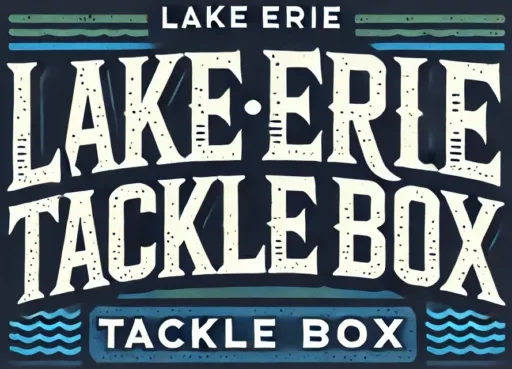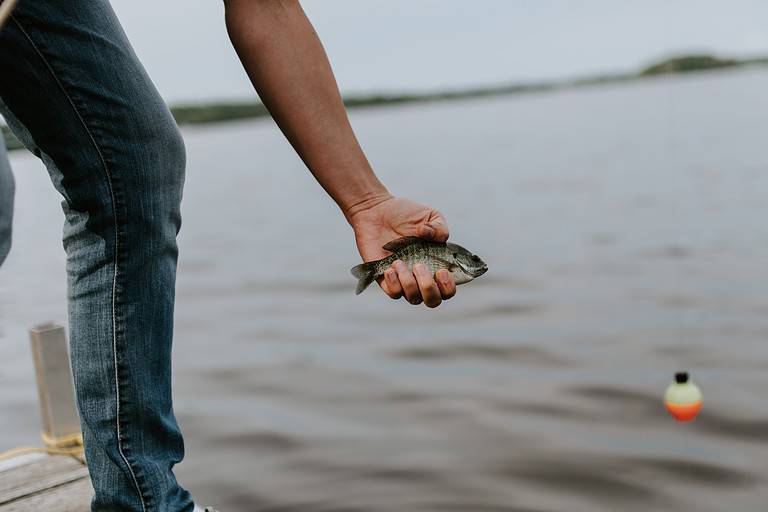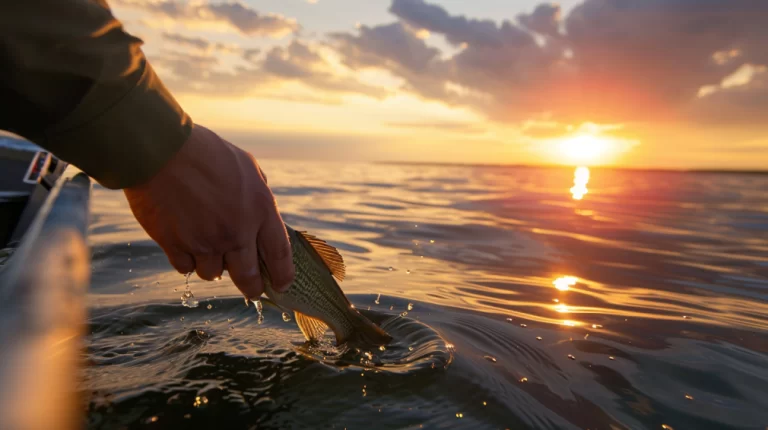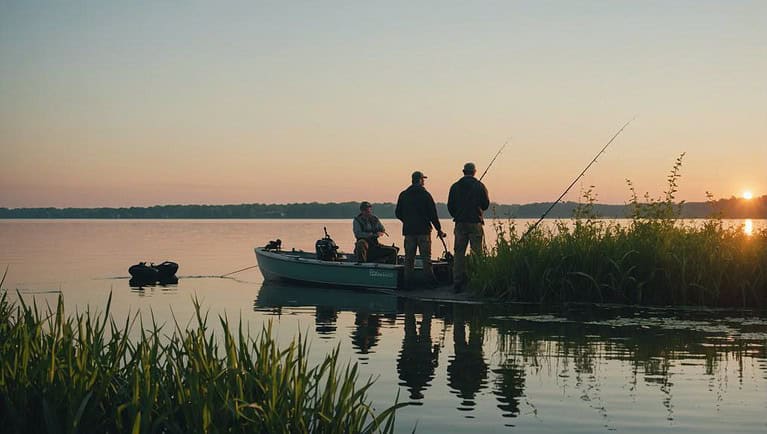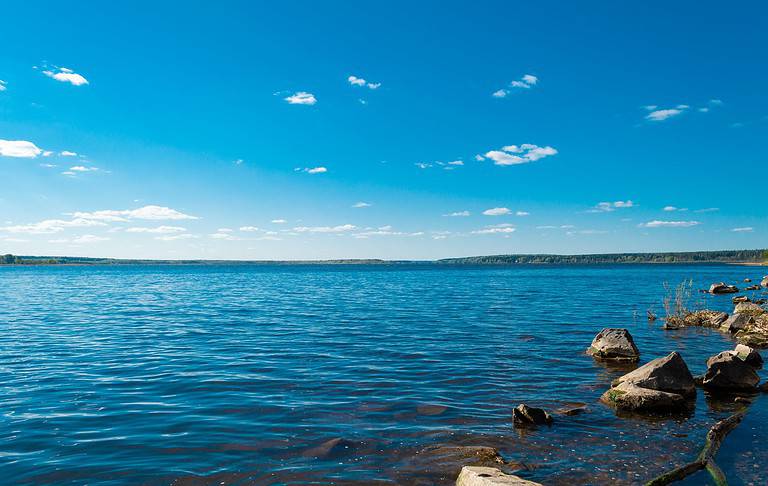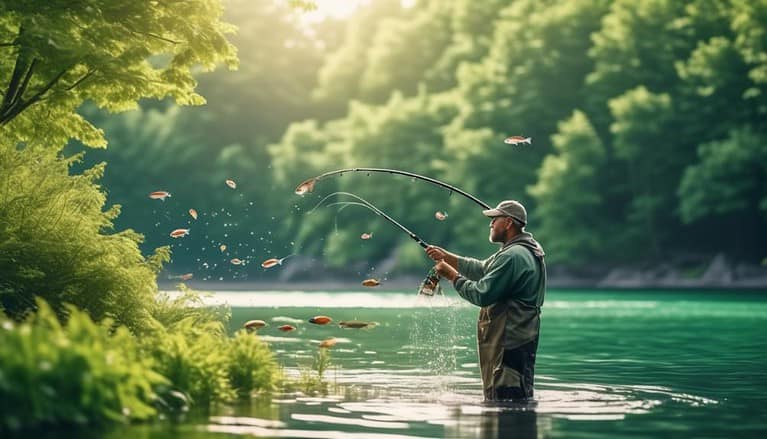Lake Erie’s Invasive Species: Impact on Fishing
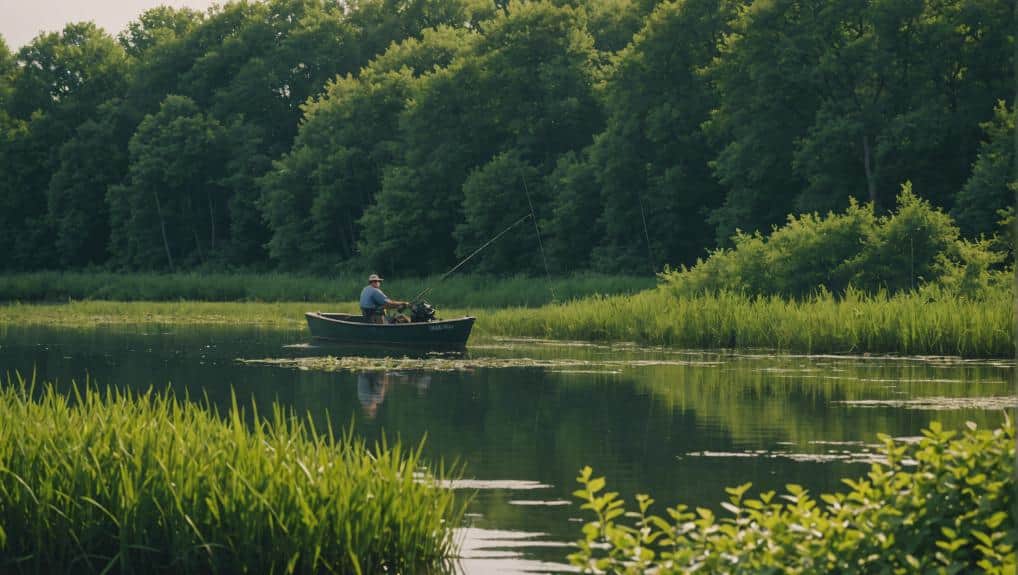
Invasive species in Lake Erie, such as zebra mussels and alewives, have disrupted the ecosystem, greatly impacting fishing. Alewives outcompete native fish like walleye and yellow perch for food, leading to their decline. Zebra mussels filter out plankton, altering the food chain and depleting resources for native species. Grass carp devastate aquatic vegetation, destroying important habitats and spawning grounds. These disruptions lower native fish populations and hurt both recreational and commercial fishing industries. Effective management strategies are vital to preserving biodiversity and supporting the local economy. Continue to explore how these measures are implemented and their long-term effects.
Main Points
- Invasive species like alewives and zebra mussels deplete food sources, impacting native fish populations and the fishing industry.
- Grass carp consume aquatic vegetation, disrupting fish habitats and spawning grounds essential for fishing.
- Alewives outcompete native fish, leading to population declines and reduced catches for commercial and recreational fishing.
- Invasive species prey on native fish eggs and larvae, exacerbating declines and affecting fishery sustainability.
- Effective management strategies are crucial to mitigate invasive species’ impacts and support sustainable fishing practices.
Overview of Invasive Species
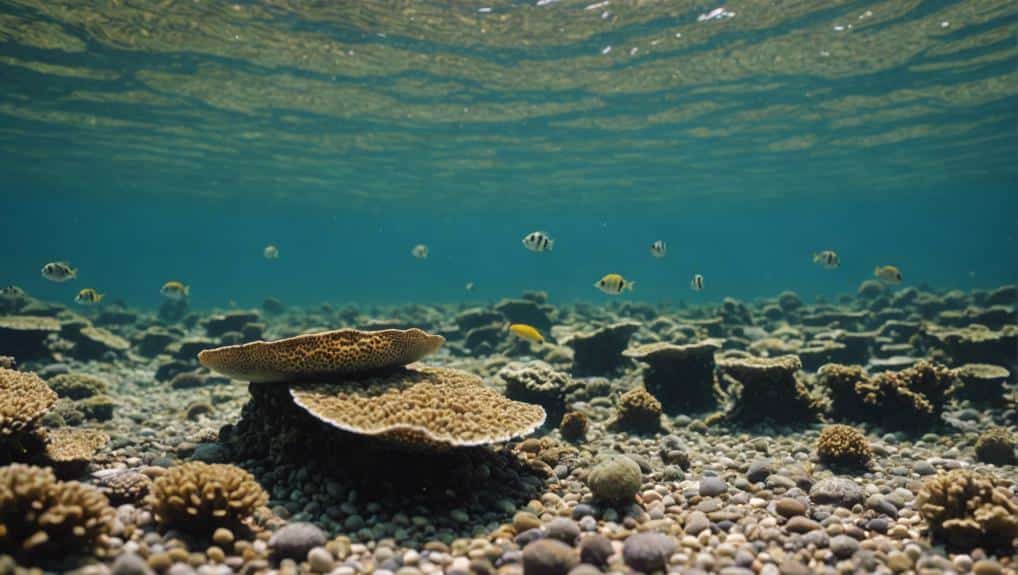
Lake Erie’s ecosystem is heavily impacted by over 185 non-native invasive species, including alewives, zebra mussels, and grass carp. When these invasive species enter Lake Erie, they disrupt the natural balance, causing significant ecological impacts.
Alewives, for instance, outcompete native fish species for food, leading to a reduction in the populations of these native fish. Zebra mussels filter plankton from the water, which deprives native species of their primary food source, thereby altering the food chain.
The presence of invasive species in Lake Erie has also led to declines in fisheries. As species like round gobies and sea lampreys proliferate, they negatively affect commercial and recreational fishing by preying on or competing with valuable fish species such as walleye and perch. This, in turn, impacts the local economy reliant on these fisheries.
Mitigating these ecological impacts requires a multifaceted approach. Management strategies include physical barriers to prevent further spread, control measures such as chemical treatments, and ongoing research to understand the dynamics of these invasive populations.
Grass Carp Impact
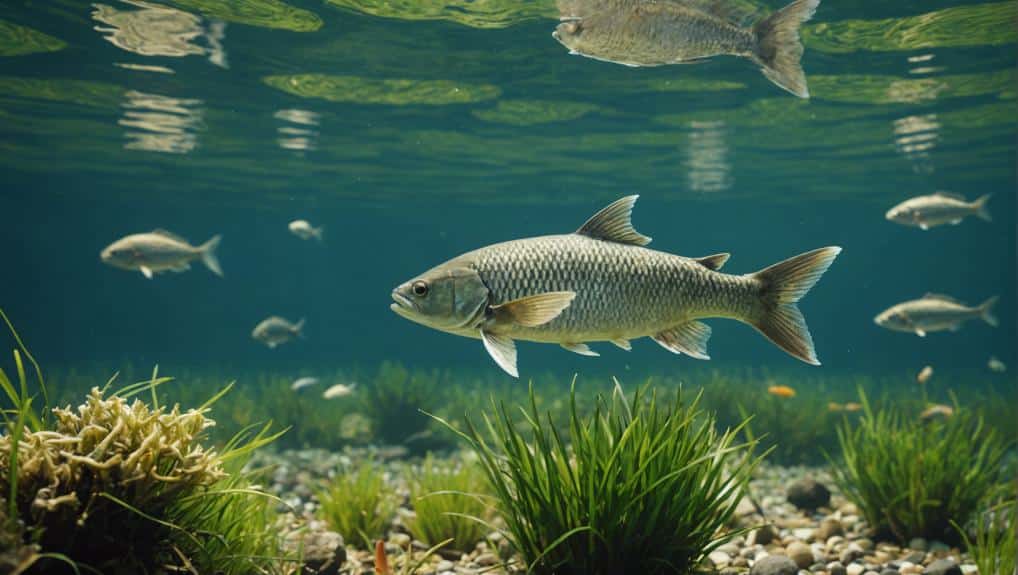
You should note the significant impact grass carp have on Lake Erie’s native vegetation, as they consume large quantities of aquatic plants daily. This consumption disrupts the habitat for native fish species, leading to altered fish populations.
Data from 2018 to 2020 shows an active effort to control these invasive carp, with increased mortality rates indicating some progress.
Disruption of Native Vegetation
Grass carp, an invasive species introduced from Eastern Asia in the 1960s, greatly disrupt native vegetation in Lake Erie by consuming vast amounts of aquatic plants daily. These herbivorous fish can ingest their body weight in plants, profoundly impacting the delicate balance of wetland ecosystems. With 5% of Lake Erie’s historical wetlands already vanished, the grass carp exacerbates the loss of essential vegetation that sustains the ecosystem’s health and biodiversity.
By devouring native vegetation, grass carp undermine the structural integrity of wetland habitats. This reduction in plant biomass decreases the availability of food and shelter for native species, leading to cascading ecological effects.
Researchers at the University of Toledo are leading efforts to track and manage grass carp populations in Lake Erie and the Sandusky River. Between 2018 and 2020, control measures led to a decline in grass carp numbers in the Sandusky River, with fewer than 200 individuals estimated.
This data indicates progress but underscores the need for continued vigilance. Effective management strategies are critical to mitigate the grass carp’s impact on Lake Erie’s wetland ecosystems, ensuring the preservation of native vegetation and the overall ecological balance.
Altered Fish Populations
While the destruction of native vegetation by grass carp is evident, their impact on altering fish populations in Lake Erie presents another profound ecological challenge. Grass carp, an invasive species introduced in the 1960s, consume vast amounts of aquatic plants, essential habitats for native fish species. This consumption disrupts the ecosystem, leading to declines in fish populations dependent on these habitats for spawning, foraging, and shelter.
Data from the University of Toledo reveals that from 2018 to 2020, fewer than 200 grass carp were estimated in the Sandusky River, with 96 captured by researchers. Despite these efforts, the presence of grass carp continues to threaten the ecological balance. Early intervention is essential to prevent further spread and degradation, as noted by Bob Mapes’ research team.
The Great Lakes Fishery Commission underscores the importance of controlling invasive species to protect the biodiversity and economic value of Lake Erie’s fishery. You need to understand that unchecked grass carp populations can lead to a cascade of negative effects on native fish populations, ultimately impacting commercial and recreational fishing. Continued research and management are crucial to mitigate these impacts and preserve Lake Erie’s ecological integrity.
Effect on Native Fish

Invasive species like alewives and sea lampreys have greatly disrupted the ecological balance of Lake Erie, leading to a marked decline in native fish populations such as walleye and yellow perch. These native fish are facing significant challenges due to resource competition, habitat alteration, and direct predation from invasive species.
Alewives, for instance, consume the eggs and larvae of native fish like lake trout, thereby reducing their reproductive success.
The impact of invasive species on Lake Erie’s native fish is profound and multifaceted:
- Resource Competition: Invasive species outcompete native fish for food and habitat, diminishing their populations.
- Predation: Species like alewives prey on the eggs and larvae of native fish, leading to lower survival rates.
- Ecosystem Imbalance: The dominance of invasive species, constituting 90% of the biomass, disrupts the food web and ecological dynamics.
Management strategies, such as lampricides and physical barriers, are essential to mitigating the impact of these invasive species on Lake Erie’s native fish. These interventions aim to restore ecological balance and support the recovery of critical native fish populations.
The ongoing battle against invasive species is vital for the preservation of Lake Erie’s native fish and overall biodiversity.
Changes in Aquatic Vegetation
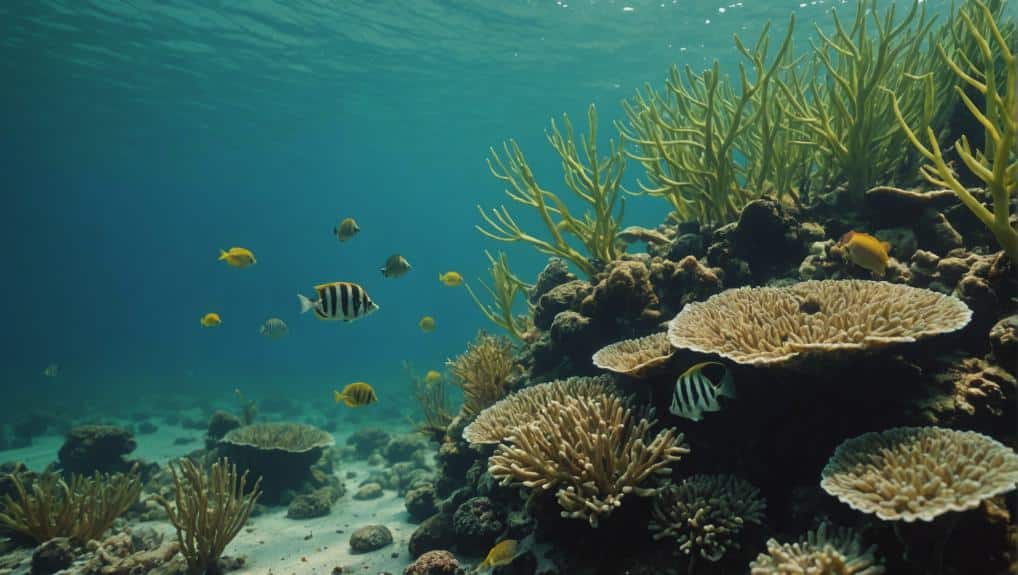
The profound impact of invasive species extends beyond native fish populations, as they also greatly alter Lake Erie’s aquatic vegetation, leading to cascading ecological consequences.
Invasive species like grass carp consume substantial quantities of aquatic vegetation, disrupting the delicate balance of the ecosystem. This reduction in aquatic vegetation directly impacts fish habitat and important spawning grounds. Without sufficient vegetation, many fish species struggle to find suitable areas to reproduce, resulting in shifts in fish populations and a marked decline in biodiversity.
The alteration of aquatic vegetation by invasive species introduces significant ecological imbalances. The lack of plant cover disrupts the food chain, affecting not only fish but also other aquatic organisms that rely on these plants for shelter and nutrition. Consequently, you see a ripple effect throughout the ecosystem, where the absence of vegetation leads to decreased water quality and increased erosion.
Monitoring and managing these invasive species are essential steps in preventing further damage. By maintaining a healthy balance of aquatic vegetation, you help preserve the fish habitat and overall health of Lake Erie’s ecosystem. Effective intervention strategies can mitigate these ecological imbalances and support the lake’s biodiversity.
Resource Competition
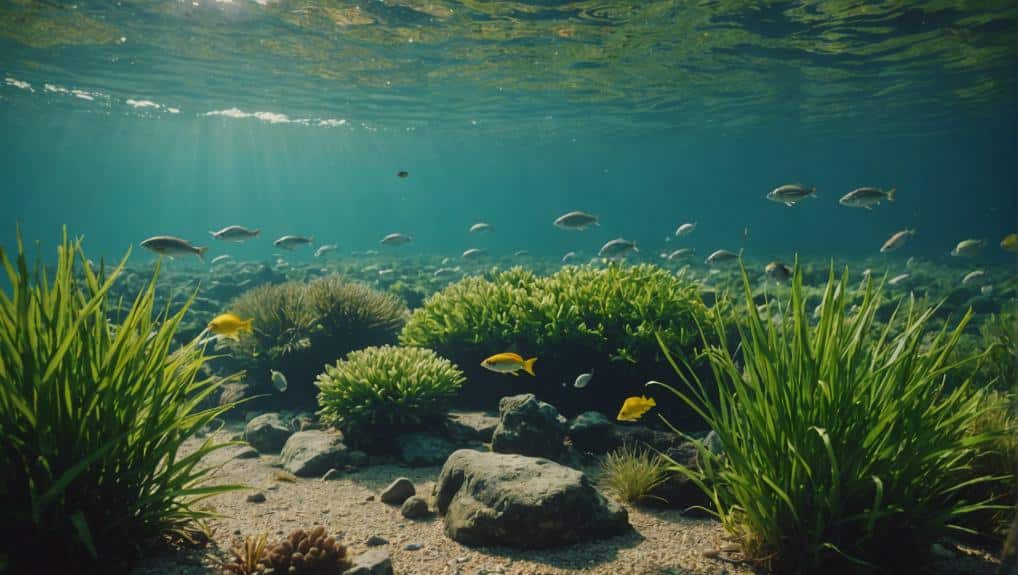
You’ll notice that resource competition from invasive species like alewives can have a considerable impact on native species decline and disrupt habitats.
Data indicates that alewives consume zooplankton and prey on native fish larvae, leading to reduced survival rates of indigenous species.
This competition alters the food web structure, resulting in destabilized fish community composition in Lake Erie.
Native Species Decline
Due to intense competition for resources like zooplankton, native fish species in Lake Erie have experienced significant population declines. The invasive species, particularly alewives, have had a profound impact on the native species. Alewives not only consume a significant amount of zooplankton, depleting an essential food source for native fish like walleye and yellow perch, but they also prey on the eggs and larvae of these native species, further aggravating the decline.
The impact on fishing, especially for recreational and commercial purposes, is severe. As native fish populations dwindle, the local fishing industry faces substantial challenges. Consider these alarming statistics:
- By the mid-60s, alewives made up 90% of the remaining biomass in the Great Lakes, illustrating the drastic imbalance caused by invasive species.
- Native fish like lake trout have seen sharp declines, directly correlating with the rise of invasive species.
- Recreational and commercial fishing industries are affected, leading to economic repercussions for communities reliant on fishing.
Management strategies, including barriers and controls, are essential to mitigating the negative impact of invasive species on native fish populations. However, the ongoing struggle underscores the need for continuous, data-driven efforts to protect Lake Erie’s ecological balance.
Habitat Disruption
Invasive species in Lake Erie disrupt native habitats by outcompeting local fish for essential resources such as food and spawning grounds, leading to significant ecological imbalances. These invasive species, like the round goby and zebra mussel, greatly alter the habitat, making it increasingly difficult for native fish populations to thrive.
Habitat disruption results in the loss of essential resources, which adversely impacts the growth and reproduction of native species. When invasive species dominate the food sources or prime spawning locations, native fish populations can decrease, leading to a weakened ecosystem. This imbalance not only affects the fish but also disrupts the entire food web, resulting in long-term ecological consequences for Lake Erie.
Here’s a look at the emotional and scientific impact:
| Impact | Native Fish | Ecosystem Health |
|---|---|---|
| Food Competition | Decreased growth rates | Altered food web dynamics |
| Spawning Ground Loss | Reduced reproduction success | Fragmented habitats |
| Population Decline | Lower population numbers | Overall biodiversity loss |
The competition between invasive and native species for resources is a significant factor in the current state of Lake Erie’s ecosystem. To maintain a balanced and healthy environment, addressing habitat disruption caused by invasive species is important.
Management Efforts
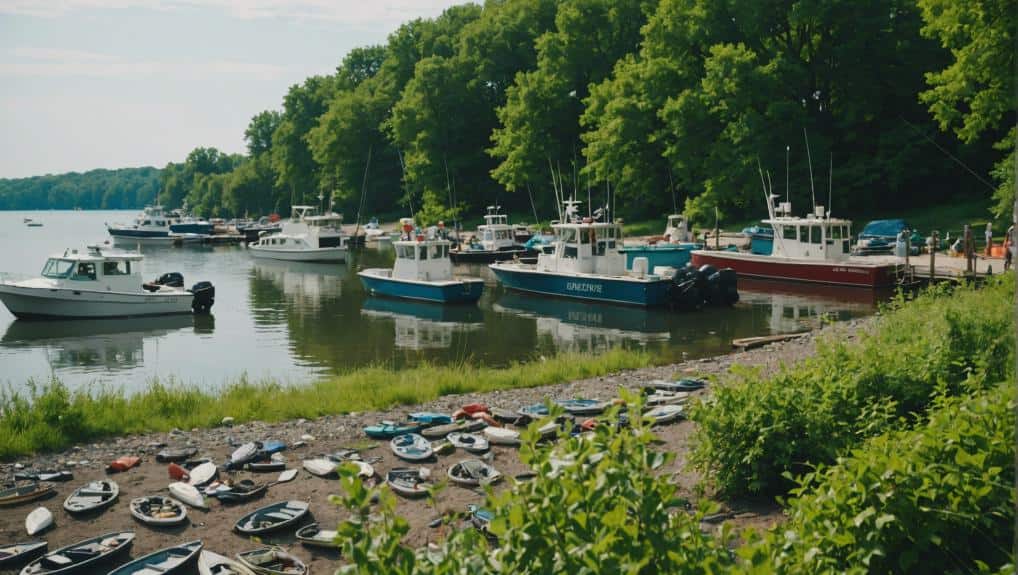
Implementing diverse management strategies, such as lampricides, barriers, traps, and supplemental controls, has been vital for controlling invasive species in Lake Erie. Management efforts specifically target grass carp, an invasive species threatening the lake’s ecological balance.
The Ohio Department of Natural Resources has launched the Lake Erie Grass Carp Response Strategy to mitigate this issue. Researchers at the University of Toledo have introduced electrofishing nets to track and capture elusive grass carp in the Sandusky River, illustrating the innovative approaches being employed.
Early intervention is essential for managing invasive species like grass carp to prevent further spread and degradation of wetland ecosystems. Effective management strategies can inform future conservation efforts and help maintain the lake’s ecological balance.
Here’s why these efforts matter:
- Preventing Ecosystem Collapse: Immediate action prevents invasive species from overwhelming native species, ensuring long-term biodiversity.
- Protecting Fishing Industries: Effective control measures sustain local economies reliant on fishing.
- Preserving Recreational Areas: Healthy ecosystems support recreational activities, benefiting local communities and tourism.
Sustainable Fishing Practices
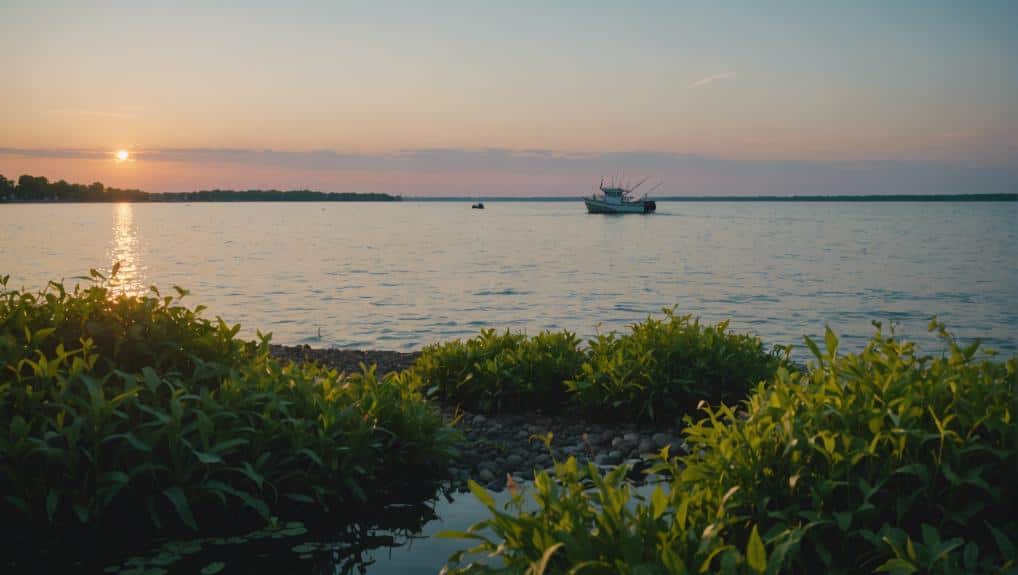
In order to guarantee Lake Erie’s fish populations remain viable, sustainable fishing practices incorporate precise regulations such as catch limits and size restrictions. These measures are designed to make certain that native fish species have the opportunity to reproduce and maintain their populations.
By setting specific limits, you help prevent overfishing and allow young fish to mature, thereby promoting a balanced ecosystem.
Your involvement in conservation efforts is essential. Protecting native fish species requires you to adhere to these regulations and engage in responsible angling. Aquatic invasive species, which can outcompete or prey on native fish, pose a significant threat to the lake’s biodiversity.
Sustainable management strategies, including monitoring programs, track the presence and spread of these invasive species. Such data-driven approaches enable you to make informed decisions that support both the fish populations and the overall health of Lake Erie’s ecosystem.
Community participation amplifies these conservation efforts. By educating yourself and others about sustainable fishing and the threats posed by aquatic invasive species, you contribute to the long-term viability of Lake Erie’s resources. Adhering to these practices ensures that future generations can enjoy and benefit from the lake’s rich biodiversity.
Conclusion
You’ve seen how invasive species like grass carp disrupt Lake Erie’s ecosystem, affecting native fish through resource competition and altering aquatic vegetation.
While some might argue that management efforts are necessary, data shows they’re just a part of the solution. Sustainable fishing practices are essential for long-term success.
By adopting these practices, you’re not just preserving a fishery; you’re ensuring a balanced ecosystem for future generations.
Let’s commit to science-backed actions for lasting change.
